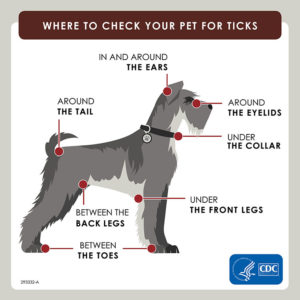Pets
 If your pet spends time outdoors, a tick check should be part of your daily routine.
If your pet spends time outdoors, a tick check should be part of your daily routine.
Dogs are especially susceptible to tick-transmitted diseases and locating a tick bite on their body can be challenging. Signs of a tick-borne disease may not appear in dogs for 7-21 days, making it especially important to monitor any changes in behavior or appetite after properly removing a tick from their body.
There are lots of products on the market today that protect your pets from tick-transmitted diseases. When applied correctly and in a timely manner, these products can greatly reduce the chances of tick bites and the transmission of tick-related diseases. The most popular tick bite prevention products are tick prevention medications, topical sprays and spot-ons. For some dog owners, especially those who live in particularly dense tick areas, these vets recommend adding a tick collar as part of your dog’s treatment.
Don’t limit tick checks to your canine family members. Dogs can’t directly transmit tick-borne illnesses to people, but ticks can move from host to host. A tick may enter your home on your dog’s back and move on to another pet or human, or a tick could hitch a ride on you and then move on to one of your pets. Cats are vulnerable, too, though typically less so than dogs because they are regular groomers. But you should still do a tick-check especially if they like to play outdoors. Starting at the head, run your fingers like a comb over the cat’s entire body.
 Ticks prefer dark, moist places, so for both cats and dogs, make sure to inspect under their tail and around the anus, belly, face, ears, groin, “armpits,” and between the toes. Remove any attached ticks with fine-tipped tweezers.
Ticks prefer dark, moist places, so for both cats and dogs, make sure to inspect under their tail and around the anus, belly, face, ears, groin, “armpits,” and between the toes. Remove any attached ticks with fine-tipped tweezers.
Permethrin is not safe when wet for cats or small dogs. Speak with your veterinarian.
Common tick prevention materials have been evaluated by the EPA and an expert veterinarian team from the US and Canada. For “Spot-on” Products, the team found that:
- how much a dog weighs matters a lot in deciding how much of a product should be used
- small breed dogs were affected more than larger breeds for some products
- misuse or accidental exposure of cats to dog products was an important problem; cats can be harmed by dog products because they are more sensitive to certain pesticides.
The FDA recommends that you:
- Don’t apply a product to kittens or puppies unless the label specifically allows this treatment.
- Talk to your veterinarian before using a product on weak, old, medicated, sick, pregnant, or nursing pets, even if they have been fine with previous uses of the product.
- keep treated animals separated from the other(s) until the product dries.
- Monitor your pet for side effects or concerning events after applying the product, particularly when using the product on your pet for the first time.
- Call your veterinarian if your pet shows symptoms of illness after using a product. Look for dizziness, wobbliness, incoordination, poor appetite, depression, vomiting, diarrhea, or excessive salivation. Some animals have had seizures and/or died.
It’s best to rely on an EPA- or FDA-approved product. There’s little evidence that homemade remedies, such as essential oil mixtures, will provide reliable protection, and there’s a chance that a homemade anti-tick concoction could harm your pet.
For more information visit the Tick Encounter Resource Center and the Humane Society.

